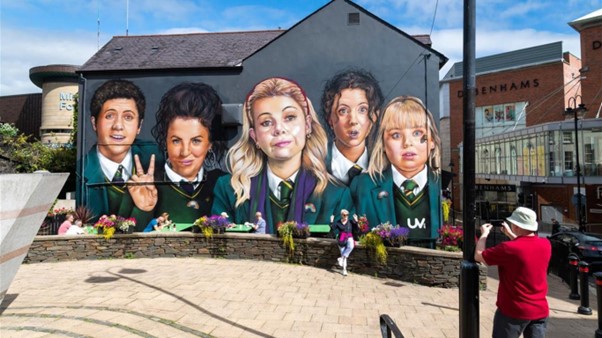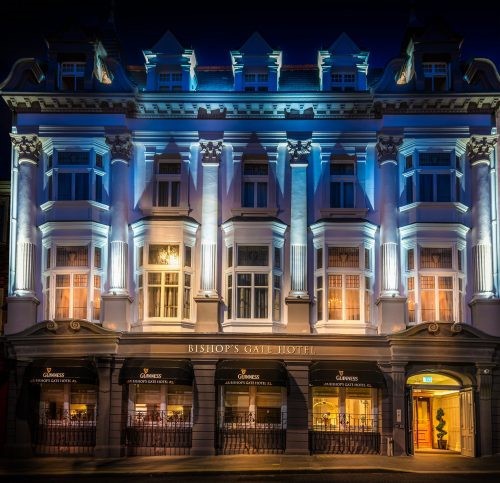
by Felicity Hayes-McCoy
Sometimes the power of TV storytelling can catapult a particular place into people’s hearts. In the 1990s when I was one of the team writing for the BBC’s Ballykissangel, engaged couples used to pose for photos in the little Wicklow village of Avoca because of the romantic association the series had brought to it. Often the places where series are shot are decided upon for purely practical reasons but, now and again, as with Channel 4’s blockbusting Derry Girls, it’s a location that inspires the magic that makes for rip-roaring success. According to Lisa McGee, who created and wrote Derry Girls, the city and its people provided her impulse to write it. Recently, on my first visit to Derry, I understood exactly what she meant.

At the end of a writers’ road trip along the Wild Atlantic Way, my husband Wilf and I drove on to spend two nights in Derry, a genius detour suggested by Golden Ireland. It took around twenty minutes to drive there from Buncrana, in Donegal, and we only realised we’d crossed the border when we saw the signage and noticed changes in the road-markings. We did manage to lose our bearings as we entered the city, but a man chatting on a doorstep with his neighbour literally ran into the street to set us on our way. It was our first taste of Derry’s spontaneous friendliness, and an indication of what lay ahead.

At the Bishops Gate Hotel, a Grade B1 Listed Building within the walled part of the city, the reception staff came to greet us as at the door. Right in the heart of the Cathedral Quarter, this luxurious boutique hotel was the perfect base from which to explore. It wasn’t easy to leave the comfort of our lovely modern room with its subtle vintage touches, but we wandered out before dinner and were captivated by the city walls. None of the photos we took really do them justice. You have to be there to appreciate how massive and impressive, they are – built between 1613 and 1619, and intended to withstand siege, they’re a full mile in circumference, up to twenty-six feet high, and have a broad rampart on top (in places as much as thirty-five feet wide) which is open to the public and makes a wonderful walk.
We had dinner in the hotel’s Gown Restaurant, next to its Wig Champagne Bar, so-called because the building, once a gentlemen’s club, is close to the law courts. The service was charming and the menu featured locally sourced ingredients expertly prepared by a team led by the hotel’s Executive Chef Paul Sharkey. Everywhere you go in Derry you find pride in what’s produced locally, whether it be food, beer, music, art or theatre, or the business enterprise that’s produced locally-owned shops, pubs, cafés and tourist attractions. And everywhere there’s quirkiness, humour and individuality. (The Bishop Gate Hotel’s owners are dog-lovers, for example, so among the portraits on its imposing staircase is one of a dog in full naval regalia.
Our first full day began at the state-of-the-art, award-winning Visitor Information Centre. It has digitised information, leaflets and displays, and a little shop. Usefully, it also sells a sightseeing pass which provides entry to ten city attractions, including Bogside and City walking tours, museums and churches. And its knowledgeable staff are super-helpful: Ciaran and Amy recognised my sunhat, which I’d dropped, and carefully put it away to return to me when I came rushing back.
Just round the corner from the information centre is Derry’s imposing Guildhall. Home to the mayor’s office, its ground-floor houses a fine exhibition which takes you through the history of the Plantation of Ulster by English colonists in the 1600s. Visitors can also view other parts of the building, where the stained-glass windows are remarkable.
One of the joys of this city is that it’s so pedestrian-friendly. Our next destination was Derry’s Craft Village, a little oasis of independent shops behind the busy main streets, where we paused for coffee and traffic-free window-shopping before moving on to the Tower Museum, only five minutes from the Guildhall.
The excellence of Derry’s museums and galleries reflects its growing international status as a cultural centre. One of The Tower’s exhibitions features the wreck of La Trinidad Valencera, a ship of the Spanish Armada that was blown off course for England and went down in a storm off the Donegal coast. The main permanent exhibition, called The Story of Derry, covers the city’s history from earliest times and, like the other museums we went to, it continues the story up to the present day, contextualising, analysing and never shirking controversy or complexity.
One of Derry’s iconic sights is the Peace Bridge, which symbolises newly-formed links between previously divided communities. Meandering in a series of curves across the river Foyle, this self-anchored suspension bridge is an expression of how the route from conflict to reconciliation takes time and patience, and is seldom straight. Among cyclists and other strolling pedestrians, Wilf and I crossed the bridge on the second day of our visit, to eat lunch at the Walled City Brewery, a family business which brews craft beer and owns a small gastropub. The award-winning food was delicious and, like most places we visited, service came with a story as well as a smile: along with beer, the brewery produces Earhart Gin, using botanicals sourced from a meadow just outside Derry where Amelia Earhart landed in 1932, thereby becoming the first woman to fly solo across the Atlantic.
As we sat at a table outside the pub, looking across the river at tall spires and distant walls, I could understand why the hashtag #LegendDerry appears on social media – and why the Guardian newspaper called Derry Girls a “cultural juggernaut”. One of Europe’s finest examples of a walled city, Derry’s energy, humour, creativity and humanity are inspiring, and our two days there weren’t nearly enough. It’s an extraordinary place that expands the mind, feeds the soul, welcomes visitors with immense warmth and generosity, and sends you away feeling that you can’t wait to return.
felicity hayes-mccoy july 2022
For more information, see:
About The Author:
Felicity Hayes-McCoy is the author of the USA Today bestselling “Finfarran” novels, published by Hachette Irl, which have been translated into seven languages and are available in hardback, paperback, ebook and audiobook. Born and educated in Dublin, she built a successful London-based career, as an actor and then a writer. Her memoir The House on an Irish Hillside, published in 2012, continues to be read worldwide. A sequel Enough Is Plenty: The Year on the Dingle Peninsula, illustrated with her own photos, was followed by a second memoir, A Woven Silence: Memory, History and Remembrance.
Dingle and its Hinterland: People, Places and Heritage, a cultural guide to West Kerry, was co-written with her husband Wilf Judd with whom she divides life and work between rural Ireland and inner-city London.
For more Information, see Felicity Hayes-McCoy

